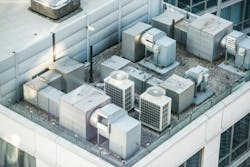Courtesy of www.MikeHolt.com.
All questions and answers are based on the 2023 NEC.
Q1: Where air-conditioning and refrigeration equipment is installed outdoors on a roof, a(an) _____ conductor of the wire type shall be installed in outdoor portions of metallic raceway systems that use compression-type fittings.
a) equipment grounding
b) grounding
c) equipment bonding
d) bonding
Q2: The grounded conductor brought to service equipment shall be routed with the phase conductors and shall not be smaller than specified in Table _____ when the service-entrance conductors are 1,100kcmil copper and smaller.
a) 250.102(C)(1)
b) 250.122
c) 310.16
d) 430.52
Q3: Locations in which combustible dust is in the air under normal operating conditions in quantities sufficient to produce explosive or ignitible mixtures are classified as _____.
a) Class I, Division 2
b) Class II, Division 1
c) Class II, Division 2
d) Class III, Division 1
Q4: Each resistance welder shall have an overcurrent device rated or set at not more than _____ of the rated primary current of the welder.
a) 25%
b) 80%
c) 125%
d) 300%
Q5: Noncombustible surfaces that are broken or incomplete around boxes employing a flush-type cover shall be repaired so there will be no gaps or open spaces larger than _____ at the edge of the box.
a) 1⁄16 in.
b) 1⁄8 in.
c) ¼ in.
d) ½ in.
Q6: Tightening torque values for terminal connections shall be as indicated on equipment or in installation instructions provided by the manufacturer. An approved means shall be used to achieve the_____ torque value.
a) indicated
b) identified
c) maximum
d) minimum
Answers:
Q1: a) equipment grounding
Section 440.9 specifies, "Where equipment is installed outdoors on a roof, an equipment grounding conductor of the wire type shall be installed in outdoor portions of metallic raceway systems that use compression-type fittings."
Q2: a) 250.102(C)(1)
As stated in Sec. 250.24(D)(1), "The grounded conductor shall not be smaller than specified in Table 250.102(C)(1)."
Q3: b) Class II, Division 1
According to Sec. 500.5(C)(1)(1), a Class II, Division 1 location is one "in which combustible dust is in the air under normal operating conditions in quantities sufficient to produce explosive or ignitible mixtures."
Q4: d) 300%
Per Sec. 630.32(A): "Each welder shall have an overcurrent device rated or set at not more than 300% of the rated primary."
Q5: b) 1⁄8 in.
Section 314.21 confirms, "Noncombustible surfaces that are broken or incomplete around boxes employing a flush-type cover or faceplate shall be repaired so there will be no gaps or open spaces larger than 1⁄8 in. at the edge of the box."
Q6: a) indicated
As stated in Sec. 110.14(D), "Tightening torque values for terminal connections shall be as indicated on equipment or in installation instructions provided by the manufacturer. An approved means shall be used to achieve the indicated torque value."
These materials are provided by Mike Holt Enterprises in Leesburg, Fla. To view Code training materials offered by this company, visit www.mikeholt.com/code.
About the Author

Mike Holt
Mike Holt is the owner of Mike Holt Enterprises (www.MikeHolt.com), one of the largest electrical publishers in the United States. He earned a master's degree in the Business Administration Program (MBA) from the University of Miami. He earned his reputation as a National Electrical Code (NEC) expert by working his way up through the electrical trade. Formally a construction editor for two different trade publications, Mike started his career as an apprentice electrician and eventually became a master electrician, an electrical inspector, a contractor, and an educator. Mike has taught more than 1,000 classes on 30 different electrical-related subjects — ranging from alarm installations to exam preparation and voltage drop calculations. He continues to produce seminars, videos, books, and online training for the trade as well as contribute monthly Code content to EC&M magazine.
